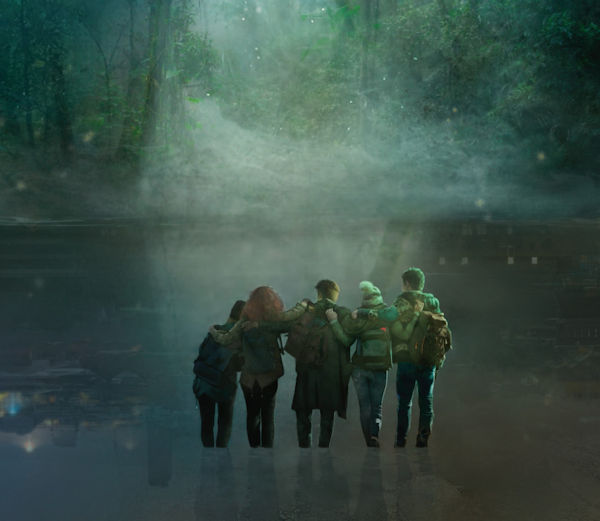
Concept and Writing: Paul Mitchener
Additional Writing: Guy Milner
Art and Layout: Jason Behnke
Rules Wrangling: Neil Gow
Logo and Cartography: Stephanie McAlea
Editing: Guy Milner and Elizabeth Behnke
Liminal is a slick British urban fantasy RPG, inspired mainly by the Peter Grant series (Rivers of London) by Ben Aaronovitch and the Dresden Files by Jim Butcher. It’s set in Britain and is about groups of people caught between the mundane world and the world of the supernatural.
This is the meaning of the term ‘liminal’—to be on the edge of two places or concepts or to be able to pass back and forth between them. Werewolves are liminal beings because they combine elements of human civilisation and untamed wildness. Ghosts are liminal beings because they are dead, but they continue to interact with the world of the living.
There are liminal places as well. The place where the sea meets the shore, for example, where land and water are in constant flux. Beach front cafés are also liminal—you might well lounge on the beach in swimwear, but you wouldn’t walk into your local coffee shop in just a swimming costume. The beach front café though, is close enough to the beach that it’s acceptable to wear anything from a bikini to trousers and a shirt.
Liminal has a focus on investigation and centres around conflicts between hidden factions of wizards, vampires, faeries, and werewolves. It uses its own unique system, which is very quick and easy to pick up, but also very easy to adapt or modify to your preferred style or setting.
Liminal embraces the myths and magical beliefs of a wide range of cultures, reflecting the diverse nature of the UK’s population. It’s also rooted in British history, with magical styles and creatures originating from the Roman occupation, Druidic traditions and the invasions of the Saxons and the Normans, respectively.
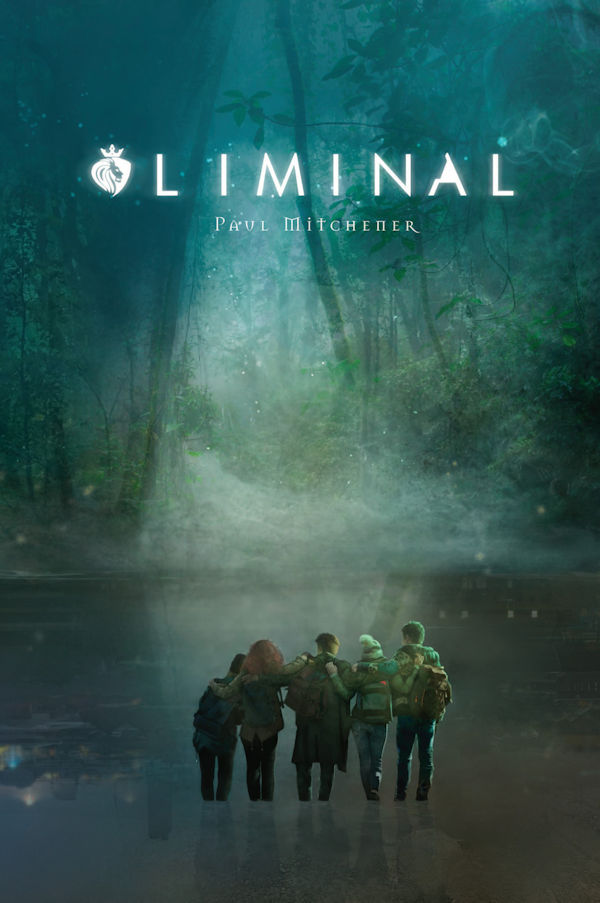 The book itself has a nice haunting cover—five people stand in shallow water with their backs to the viewer. They are gazing into a darkly luminous forest, thick with mist and pinpricked by what may be faerie lights.
The book itself has a nice haunting cover—five people stand in shallow water with their backs to the viewer. They are gazing into a darkly luminous forest, thick with mist and pinpricked by what may be faerie lights.
In fact, the art throughout is a treat for the eyes—brooding and dreamlike and often appearing photorealistic, despite its fantastical nature. Weirdly illuminated landscapes, menacing or enchanting beings, mortal investigators going about their daily tasks, and scenes of myth. As with the writing, the art depicts a wide range of people, which is always a plus. It’s also very plentiful, barely a page goes by without a tattooed mystic, eerie Fae, armed hunter or savage werewolf staring out at you. (Some of the figures depicted, both male and female, are shown in what some might call sensual poses, while wearing little clothing, though it’s all in good taste, in my opinion.)
I have almost nothing but good things to say about this book, but I will mention one tiny, tiny niggle. Though the chapters have clear themes such as Magic or Liminal Britain, they are titled Chapter 1, Chapter 2 etc. The actual name of the chapter, e.g., Character Creation, is in smaller type beneath the chapter number. This makes it a little harder to navigate the PDF, though it is fairly well hyperlinked.
Chapter 1: Introduction
“We’re outsiders, all of us, we Liminals. We don’t fit into the mortal world—we know too much, or can do too much. But we also don’t fit into the Hidden World. We’re human as well as supernatural, not like the Fae and the vampires. The big factions will use us, control us, spit us out.”
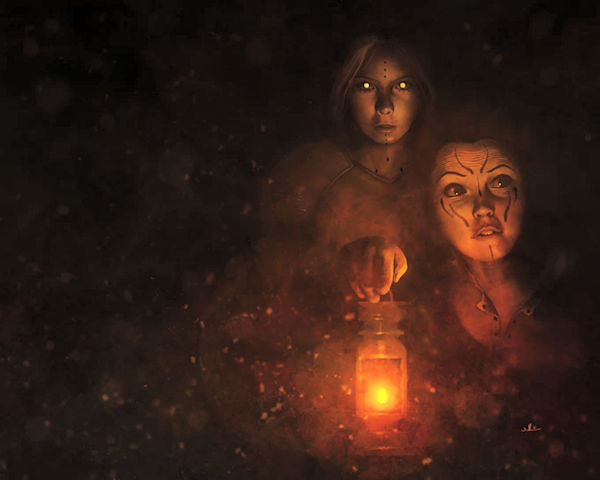
This quote sets the tone of the game. Unlike say, the World of Darkness, you do not play full members of the supernatural community—ghosts, vampires, or true Fae. Liminal PCs are touched by the Hidden World but remain apart from it. This makes them very useful to the different supernatural factions—they can go where the monsters can’t and use all the skills of a modern human. It can also make them a dangerous inconvenience that must be crushed.
This chapter has a very brief description of what RPGs are, before moving on to explaining the Hidden World. There’s also a quick rundown of what the different chapters are about. This sets the tone of the book as a whole—terse, to the point, yet full of useful information. Combined with the copious art, this makes for an easy read. Here are a few key points:
- Magic is real, and so are magicians. The most powerful or well-known societies of magicians in Britain are the Council of Merlin—a rich and hugely influential old boys’ network, and the Mercury Collegium—criminals who use magic and the supernatural to their advantage.
- Vampires are real and are uniformly monstrous. In Britain they are ruled by a large faction called The Sodality of the Crown.
- Ghosts are real. Older ghosts can become very powerful. There are also pocket dimensions called Ghost Realms.
- Fae are real. They have their own pocket dimensions called Fae Domains, these are difficult to enter and dangerous to explore.
- Werewolves are real and tend to form roaming gangs, one large family is trying to pull them together into a united faction.
- There are people in the major British Churches and in the police force who are aware of the Hidden World and work to defeat its more murderous inhabitants.
- The general public do not know any of this. Most supernatural beings can appear human most of the time. Misinformation is planted by vampires and magicians alike. The cross-faith organisation known as The Order of St. Bede works to stamp out knowledge of the Hidden World even as they stamp out its denizens.
Unusually, the media which inspired Liminal is placed up front, in this chapter. That emphasises how tied Liminal is to the urban fantasy genre. Aside from the previous examples, the book mentions Neil Gaiman’s Neverwhere, Anansi Boys and The Sandman; The Golem and the Djinni by Helen Wecker; Jonathan Strange and Mr Norrell by Susanna Clarke, War for the Oaks by Emma Bull; the Mabinogion and more.
Nonfiction is also mentioned, including Notes from a Small Island by Bill Bryson, The Fabled Coast: Legends & Traditions from Around the Shores of Britain and Ireland by Sophia Kingshill, The Land of the Green Man: A Journey Through the Supernatural Landscapes of the British Isles by Carolyne Larrington, and Black and British: A Forgotten History by David Olusoga.
TV influences include the original (UK) version of Being Human, Buffy the Vampire Slayer, Supernatural and Constantine.
Chapter 2: Character Creation

Creating a Player Character (PC) in Liminal requires you to make a few fairly simple choices.
First, describe your character’s Concept. Are they a part-Fae artist, unwillingly tied to a Fae court? A rogue wizard? A monster hunter? An academic studying occult mysteries?
Then, give them a Drive, i.e., the reason they are involving themselves in the Hidden World. Are they avenging a fallen friend? Trying to learn the secrets of their own origins? Just hoping to make a quick buck the only way they know how? Or do they want to master the powers of sorcery?
Then, pick a Focus. There are just three of these—Tough, Determined or Magician.
Tough characters get extra Endurance (Health Points), and access to handful of Tough Talents. Determined Characters get extra Will (mental endurance), and access to a handful of Determined Talents. Magicians get no immediate bonuses, but gain access to Traits relating to the various styles of magic.
Next, you spend seventeen points on Skills.
“Skills represent a character’s training and natural abilities. Most of what a character knows how to do is defined in terms of their skills.”
Skills start at zero, one point increases them by one rank, up to a maximum of four. Two points in a Skill represents a professional level of competence. Three or more allows you to buy a Speciality in that Skill which grants a further bonus in specific circumstances.
To use a Skill in game, simply roll 2D6 and add the Skill Rank.
The Skill list is fairly standard. There are twenty-one Skills, divided neatly between Physical, Mental and Social. These include Art, Lore, Melee, Stealth, Streetwise, Taunt and Vehicles. Each Skill gets a paragraph of description and some sample Specialities e.g., Knives for Melee, Flattery for Charm, or History for Education. These all made sense to me, though I have seen a lot of skill lists in my time.
What’s more, thought has definitely gone into making these Skills relevant to the setting. Artists often feature in urban fantasy. Liminal acknowledges this and gives a mechanical reason to invest points in the Skill—it powers Fae glamours. Business lets you navigate corporate power structures or run your own business but also helps you when making deals with the Fae. Conviction can cover religious faith as well as inherent strength of will. Knowledge of Science and Technology is rare in the Hidden World. But scientists may be drawn to inexplicable phenomena and tech experts can give supernatural factions an edge over the opposition.
Then, you have five points to spend on Traits. Each Trait costs either one or two points.
“Traits are specially trained or innate advantages that stand apart from Skills”
Most Traits are called Exceptional Abilities and are available to all characters. These Exceptional Abilities include mortal abilities, such as— being very rich or a crack shot, having a talent for research, being a trained investigator or being skilled in breaking and entering.
There are also a number of abilities drawn from urban fantasy and folklore. You might be supernaturally terrifying or inhumanly enchanting. You could be forgettable—those who meet you briefly will soon lose the memory of your existence and even cameras will only show your presence as a vague blur. You may regenerate from all but the most terrible of wounds. You could have inhuman strength or the ability to see in the dark.

Words that Bind is particularly flavourful. You are adept at manoeuvring others into promises. Anyone who dares to break such a promise takes damage to their Will.
You can also choose Limitations if you wish. Familiar to anyone who’s played old school World of Darkness, or many other classic games, Limitations are consequences of your supernatural nature or restrictions on your supernatural abilities. Just as with those older games, taking Limitations gives you another point or two to spend on Traits.
There is the classic Obliged Limitation, which ties you to a specific powerful supernatural being. Oathbound makes it difficult for you to tell a direct lie. There is also Vulnerability, which means you take extra damage from certain substances and are seized with dread when encountering them.
Incidentally, Liminal defies folklore and states Fae are vulnerable to bronze rather than cold iron. Presumably because bronze is harder to get hold of.
You will also need to calculate your Attributes.
Traditional RPG attributes or characteristics like Strength are covered by Skills and Traits in Liminal. Your only Attributes are Endurance and Will—pools of points that can be lost or spent during the course of play.
Endurance is 8, plus your Athletics Skill, if any. Will is 8, plus your Conviction Skill, if any.
You will also need to note down whether you get a bonus to damage, Endurance or Will from any of your Traits, or your Focus.
That’s it.
 It’s a very simple system, with very few numbers to crunch, but lots of flexibility. In fact, you could fit a Liminal character sheet onto a post card. Or perhaps half a side of A4 if you included descriptions of their Traits. And the flexibility offered by Traits and Limitations makes building supernatural characters rather more interesting. You can make your dhampir (part vampire) allergic to garlic or cause your werewolf to suffer from terrible rages, but you don’t have to.
It’s a very simple system, with very few numbers to crunch, but lots of flexibility. In fact, you could fit a Liminal character sheet onto a post card. Or perhaps half a side of A4 if you included descriptions of their Traits. And the flexibility offered by Traits and Limitations makes building supernatural characters rather more interesting. You can make your dhampir (part vampire) allergic to garlic or cause your werewolf to suffer from terrible rages, but you don’t have to.
You get plenty of chances to see this in action. The chapter begins with a list of character templates and ends with a crew of named characters.
The Character Concepts (templates) are simple and straightforward. They are two to a page and each one is accompanied by a gorgeous black and white character portrait. Each one contains a bit of a description and some sample Skills, Traits and Limitations to choose from. It’s a bit like choosing a Class or Profession in a different game. These are as follows:
- Academic Wizard. Universities in the UK are recruiting grounds for wizards as it turns out. Makes sense to me!
- Changeling. The offspring of humans and Fae, they are doomed by birth to become Liminals. Though they can be beautiful, changelings are marked out by animal features, mismatched eyes, or unusual skin patterns. They have a natural talent for glamour but may have to contend with supernatural obligations or even uncontrolled rage.
- Clued Up Criminal. Hidden societies are a natural refuge for criminals. This character is mortal but finds opportunities in the Hidden World nonetheless.
- Dhampir. Vampire awesomeness! Not the offspring of a human and a vampire, but rather a rare instance of a vampire who has retained their humanity. This doesn’t necessarily mean they won’t fall to their true nature in due time.
- Eldritch Scholar. Someone who has uncovered the Hidden World through their own studies. Not a magic user themself, but knowledgeable about the occult.
- Face. A diplomat of the Hidden World. More of a talker than a fighter.
- Gutter Mage. An informally taught magician, looked down on by the establishment but no less powerful for it.
- Investigator. The classic private detective or police officer who has found their way into places they shouldn’t be or knowledge they shouldn’t possess.
- Knight. An agent of a supernatural faction. They often have military training but are just as likely to be lawyers or hackers or other useful people.
- Man in Black. A member of the Order of St. Bede, who fights to contain the Hidden World. They must take the Tough Focus, which is odd as their suggested Traits include forms of magic.
- Warden. A bodyguard to a magician or Man in Black.
- Werewolf. Much as you’d expect. Although Liminal’s werewolves have willingly undergone a mystical initiation, rather than surviving a werewolf attack.
The Sample Characters are a crew of four Liminals called The South Yorkshire Irregulars. A changeling, a werewolf, a former police detective, and a rogue magician. They all have relationships with supernatural beings or factions (mainly antagonistic ones), and a reason to get involved in the Hidden World.
We do also get a couple of paragraphs on money and equipment. Including a description of how much money you can throw around and a reminder that guns are prohibited in the UK. You might need more than a cricket bat and a plucky attitude to take down a raging werewolf however, so there is a description of how to acquire illegal items using the Streetwise Skill.
Chapter 3: Crews and Factions
A Crew in Liminal is a group of PCs with reason to work together and solve cases. They are not big players in the Hidden World. They may be a team that works for a particular faction, or they may be independent operators. They may work together for mutual survival, or they may have a specific job such as guarding an area or hunting vampires. Buffy and her Scooby Gang are a good example of a Crew. As are the main characters in the recent Truth Seekers TV series by Nick Frost and Simon Pegg. A single squad in P Division could also be a Crew.
The Crew needs to be built like a character, with a central motivation for taking on cases and existing relationships with local factions. A kind of voting system establishes the Crew’s relationships with the major local factions. (The book emphasises individual PC motivations should not contradict the Crew’s motivation, heading off one potential problem.)
You also pick Crew Assets (one for each Player), such as a base of operations, a powerful patron, a weapons cache, an occult library, or a group of mundane but useful associates. And each Player comes up with a hook, which the GM can use later in the campaign. E.g., bloodless bodies turning up in the local canal.
We get four sample Crews, each based in a different part of the UK and possessing a different core motivation.
It’s all simple, straightforward, practical and to the point.
Chapter 4: Game Rules
As previously noted, Liminal has a very straightforward and elegant core mechanic, roll 2D6 and add your Skill Rank, if any. Some Traits can add bonuses as well. Compare that total to the Difficulty (usually 8 but it can vary). If you match or beat it, you’ve succeeded. If you succeed by enough, you get a critical success. This means an expert is more likely to get a critical success than an amateur, which makes this system far better than the flat crits and fumbles system of D&D.
It’s expected PCs will succeed at tasks they’re trained in most of the time. They’re not super-powerful badasses, but they are competent and effective in their chosen field(s).
Players can spend their characters’ Will points to improve the result of dice rolls, giving them a way to power through bad rolls. Running out of Will leaves a character stunned however, so this is a risky move. Particularly because ghosts and other supernatural creatures have ways of draining or damaging Will.
Magic uses the same system, with certain styles relying on certain Skills.
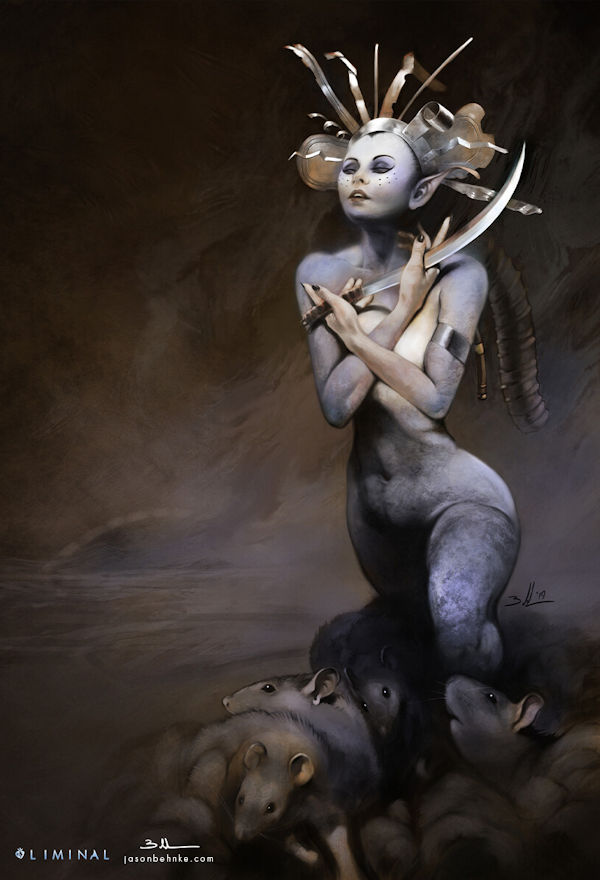 Combat does the same. Damage is a straight 1D6 with a bonus based on the weapon used and any other factors such as supernatural strength. This does mean hitting someone with fists is almost as effective as stabbing them with a knife, which doesn’t seem very believable. But it does keep everything simple and straightforward. And, regardless, with a hit easily doing four or five points of damage on average and characters who can have Endurance as low as 8, combat can get very brutal very quickly. (Particularly because one of the options for a critical hit is inflicting an extra 1D6 damage.)
Combat does the same. Damage is a straight 1D6 with a bonus based on the weapon used and any other factors such as supernatural strength. This does mean hitting someone with fists is almost as effective as stabbing them with a knife, which doesn’t seem very believable. But it does keep everything simple and straightforward. And, regardless, with a hit easily doing four or five points of damage on average and characters who can have Endurance as low as 8, combat can get very brutal very quickly. (Particularly because one of the options for a critical hit is inflicting an extra 1D6 damage.)
Initiative also uses the Skill system. It does favour the NPCs slightly, but it’s easy to understand and follows the core mechanic.
Factors such as cover, or magical invisibility add a bonus ranging from 2 to -2 as appropriate. A few examples are provided.
I wasn’t so keen on group tests.
“To pass a group test, the group needs a number of successes equal to the number of players taking part.”
This is a neat enough mechanic, but it effectively gives the Players no advantage for working together on a particular task. It would only seem to be useful for when they’re forced into a shared action, such as escaping a Fae monster.
Character advancement is a matter of ticking certain boxes e.g., you completed a case, you failed a roll. Tick enough boxes and you can increase a Skill by one Rank. Less regularly, you can gain a new Trait or other powerful advance.
Overall, this is a very clean, easy, flexible, and effective system.
Chapter 5: Magic
Each style of magic in Liminal has one or two core effects. Buying the Trait for that style grants you access to those core effects. You can then spend further points to unlock more specialised effects with that style. All the styles require the magician to spend at least one point of Will to do any serious effects. Most require a Skill roll as well, most often Lore.
This book presents eight styles of magic. Blessings and Curses, Divination, Geomancy, Glamour, Necromancy, Shapechanging, Ward Magic, and Weathermonger.
Blessings and Curses lets you grant bonuses to yourself or an ally. It also lets you inflict Will damage on a target and, if you reduce them to 0 Will, curse them to die or suffer some other unpleasant fate. Extra Traits include the power to heal physical ailments with magic and the power to protect yourself or another with magic. Another extra Trait lets you physically injure people with your curses (inflict Endurance damage), in addition to the usual effects.
At the base level, Divination only lets you learn facts about the present. Further Traits must be purchased to gain the ability to read the past or the future. The more obscure the knowledge you seek, the harder the Skill roll to learn it.
“What you seek must be known by more than 13 people. There is a reason secret cabals have a maximum size when it comes to their inner circles.”
(That’s a very cool little detail.)
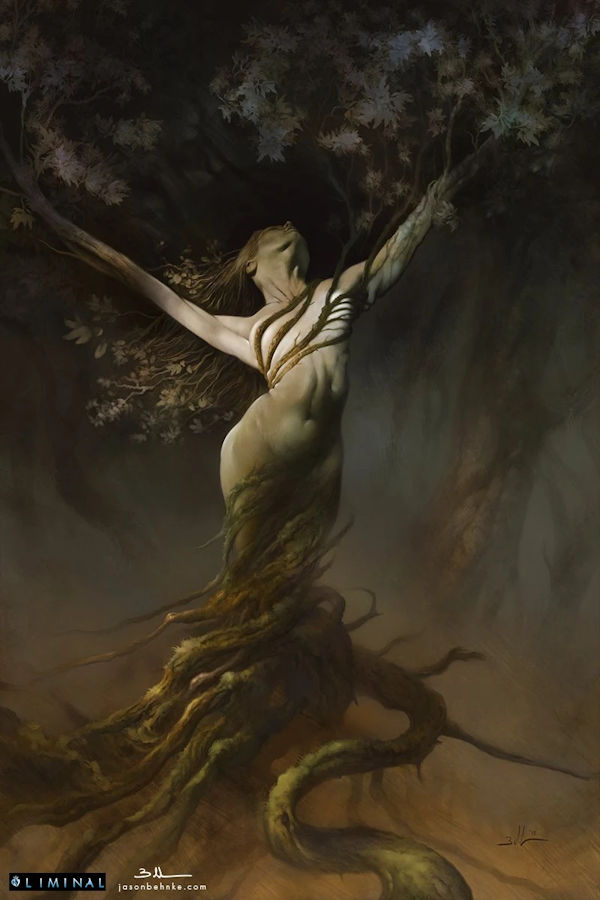 Geomancy is very unique and flavourful. I’ve run across it in urban fantasy fiction quite a bit, but rarely heard of its use in RPGs. (With the possible exception of Werewolf: The Apocalypse and Kindred of the East.) It lets a magician attune to a particular location and draw magical energy from it, which they can use to boost their Skill rolls. A Geomancer also gets a sense of the flow of magic in their territory. They can unlock some really cool additional effects too. The most unsubtle of which lets them attack a target with the landscape itself—sudden sinkholes, a swerving car etc.
Geomancy is very unique and flavourful. I’ve run across it in urban fantasy fiction quite a bit, but rarely heard of its use in RPGs. (With the possible exception of Werewolf: The Apocalypse and Kindred of the East.) It lets a magician attune to a particular location and draw magical energy from it, which they can use to boost their Skill rolls. A Geomancer also gets a sense of the flow of magic in their territory. They can unlock some really cool additional effects too. The most unsubtle of which lets them attack a target with the landscape itself—sudden sinkholes, a swerving car etc.
Even more powerful, if used right, is the ability to harvest Will from a site. If combined with styles like Ward magic, which uses Will to create permanent effects, this is the key to becoming one of the most powerful practitioners in the setting.
Glamour is the Fae magic of creating illusions. Glamourists can unlock the ability to make their illusions permanent effects or to have them inflict mental damage on those who see them.
Necromancy lets the magician see, summon, and speak to ghosts. Necromancy isn’t necessarily evil, in fact exorcism is one of its unlockable extra powers. Admittedly, other Traits include the power to raise corpses as undead servants and the horrible practice of draining youth and vitality from living beings.
Shapechanging has two forms. Lycanthropes, such as werewolves, can turn into a single animal shape. Lycanthropes often gain other supernatural Traits as well, such as night sight or enhanced strength or healing. The more powerful shapechangers can turn into two or more animal shapes and can also gain appropriate animal or supernatural Traits. Most shapechangers come from an Irish tradition, apparently.
Ward Magic lets the magician make and disable magical traps that warn them of intruders or inflict harm. Weapons can be warded as well, gaining a powerful charge of magical energy for a single strike. Further Traits include the ability to make Stone of Truth—an enchanted stone that prevents anyone holding it from telling a direct lie. And the Geas, which inflicts physical harm on a target who fails to follow a certain condition.

Weathermonger lets you control the weather, of course. It has the potential to be the most awesome and awe-inspiring style in the game. At the base level you can simply change the weather, given time. With the right Traits you can walk through a blizzard without taking harm or leaving a trail, throw gusts of wind the way other people throw punches, or strike your enemies with lightning from the sky.
Overall, much like the base system, Liminal’s magic system is very easy to understand and apply. I liked the way learning multiple styles doesn’t necessarily make you more powerful than someone who has delved deeply into one particular form of magic. I really liked how the possibilities of combining different styles and Traits set my mind racing.
This is also the closest I’ve seen to a magic system that replicates a lot of the magical abilities you see in urban fantasy fiction. (Scion could give it a run for its money, but Scion takes more time and effort to get to grips with.)
Chapter 6: Supernatural Beings and Factions
Factions are a very important part of the lore of Liminal. Each faction comes with two or three NPCs—either typical or interesting members of the faction, or heavy hitters.
The Council of Merlin
This group dates back to just after the end of Roman rule in Britain. They are far less powerful than they once were, but still wield considerable sway and respect in both the mundane and Hidden worlds. They’re all very rich and they have a substantial number of apprentices, allies, and hangers-on to bolster their limited numbers. Not to mention access to a huge library of occult tomes and various magical artefacts. Don’t be in a rush to sign up though, they are hidebound and conservative—they have just eighteen full members and it costs half a million pounds to “request” membership.
The Council seek to gather greater magical power and to prevent the “wrong sorts” of wizards from getting out of hand. When a big problem arises, they send in Phineas Morgan—a master of weatherworking, ward magic, and swordsmanship. (Don’t get in his way.)
The Fae
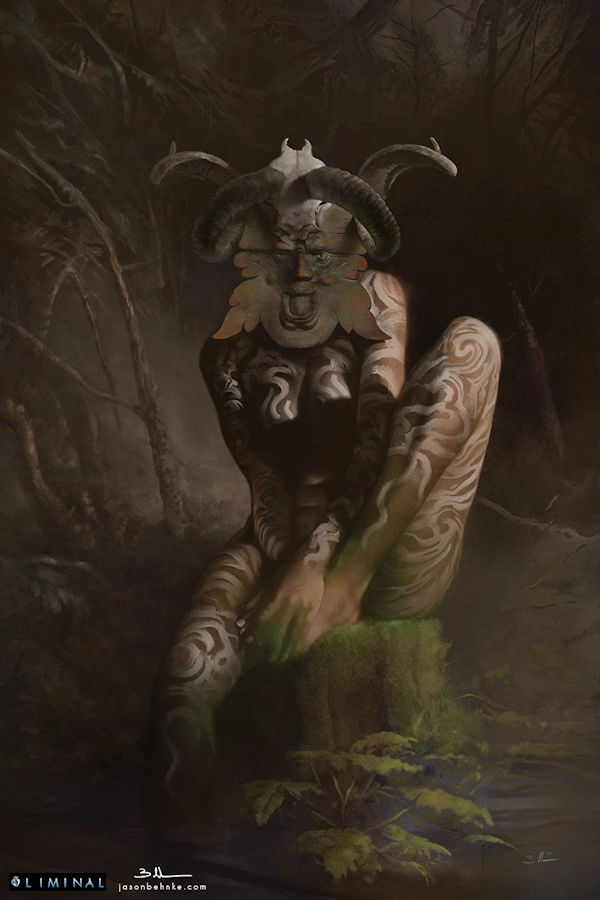 Ancient, capricious, yet bound by strange rules, the Fae are an enigma. Their sense of fashion is usually a couple of centuries out of date, currently they tend to look Victorian.
Ancient, capricious, yet bound by strange rules, the Fae are an enigma. Their sense of fashion is usually a couple of centuries out of date, currently they tend to look Victorian.
Fae are divided into different courts. The ruler of a court is very powerful and has complete free will. Lesser Fae seem to have less free will and a limited sense of self and may simply be extensions of their ruler.
Fae courts are also locations which can be accessed through hidden paths, though only if one passes a challenge such as answering a riddle or defeating a monster.
Two particularly powerful courts are mentioned:
The Court of the Queen of Hyde Park: The Queen of Hyde Park is a Fae monarch with a hidden Domain in the heart of London. She rules over all of London’s Fae, and has reach throughout England. The Queen is a manipulative dealmaker, trading in favours and less substantial services. She uses these deals to increase her influence.
The Court of the Winter King (A Scots Fae monarch): Whereas the Queen of Hyde Park represents the civilised face of the Fae, the Winter King’s influence is in wild and cold places. He avoids humanity, apart from certain ritual elements of his existence such as the taking of a wife and the murderous midwinter hunts, but he is still very powerful.
River Spirits (a clear nod to Rivers of London), are also categorised as Fae. Mother Severn is a hoary old creature who will send monsters to kill your enemies if you propitiate her with human sacrifices. Two river gods claim power over the Thames—Isis, who deals in dreams and memory and dwells in Oxford. And Temese, who presents himself as a brash young businessman.
Ghosts
 Ghosts in Liminal are echoes of the living rather than actual souls. They tend to fade away after a week or so. Particularly angry or powerful ghosts can linger and gain sentience, or at least the appearance of sentience.
Ghosts in Liminal are echoes of the living rather than actual souls. They tend to fade away after a week or so. Particularly angry or powerful ghosts can linger and gain sentience, or at least the appearance of sentience.
Powerful ghosts can build themselves physical bodies out of dust. These bodies can be destroyed, although the ghost remains active, unless banished or otherwise dealt with. Very powerful ghosts can inhabit dead bodies and rise as revenants.
Just as ghosts are echoes of people—“a Ghost Realm is an echo of a place long gone. Vanished streets and buildings can still exist as Ghost Realms. Ruins appear as they were in their prime.” Ghost Realms are traps, they are easy to enter and hard to leave. Some of them are ruled over by extremely powerful and malevolent spirits who will actively hunt invaders. Regardless, anyone trapped in a Ghost Realm eventually becomes a ghost themself. All this makes them perfect adventure fodder.
Personally, I much prefer settings which explore true afterlives and follow the souls that pass into them. But then, there’s nothing in Liminal’s lore which outright says souls don’t exist or there isn’t somewhere they end up, it just isn’t the Ghost Realms. Readers can draw their own conclusions or add their own cosmologies as they wish. (And the thought of wandering through pre-Blitz London or Viking York, without actually having to deal with time travel, is definitely appealing.)
Mercury Collegium
A loose collection of thugs, rebels, and thieves who make their living from the Hidden World. They include mortals, magicians, and supernatural beings. They seldom bother with purely mundane crimes, though sometimes a magical crime will have a mundane component.
Their sample NPCs include—Abigail Nenge, changeling glamourist and rebel, and Grant “Tealeaf” Warne, a deadly magical assassin.

Order of Saint Bede
An organisation dedicated to fighting the supernatural. Both the Anglican and Catholic churches sponsor them. They include some magicians, but regard magic as a sin. They feel humanity should be protected not just from the Hidden World, but also from the knowledge of magic. They have ties to a Muslim organisation called The Open Knot, which also fights supernatural beings but would prefer to spread the knowledge of their existence, rather than suppress it.
P Division
A specialist division of the UK police that deals with crimes involving magic and creatures from the Hidden World. They are out of the public eye and mocked by others in the police force who know they exist, but they are not entirely secret. (Though Home Secretaries are generally not informed of their existence, due to the lack of trust the Civil Service has for the people who usually fill that office.) The Chief Inspector of P Division is a vampire hunting bruiser.
This section also includes some details about policing in the UK.
Vampires and the Sodality of the Crown
Vampires in Liminal don’t just need blood, they are also inherently sadistic, they struggle to resist the urge to inflict anguish on humans. (Rather like the demonic vampires in Buffy and Angel.) Vampires can dominate any human that drinks their blood and are masters of manipulation and influence.
The Sodality of the Crown dates back to the Roman Occupation, oversees most of the vampires in the UK and seeks to take over the British government. They operate in cells of five to twenty individuals, ruled over by a vampire lord. Vampire lords are suitably appalling foes and can be customised to your taste.
One notable (and extremely dangerous), vampire is Hereward the Wake. A former dhampir of Saxon origin, he has not forgiven the British Fae for their part in the Norman Conquest. More recently, P Division have started to annoy him too. Hereward is a great vampire NPC; I love the idea of a being who still clings to a thousand-year-old grudge and yet is adaptable enough to remain effective in the modern world.
Werewolf Gangs
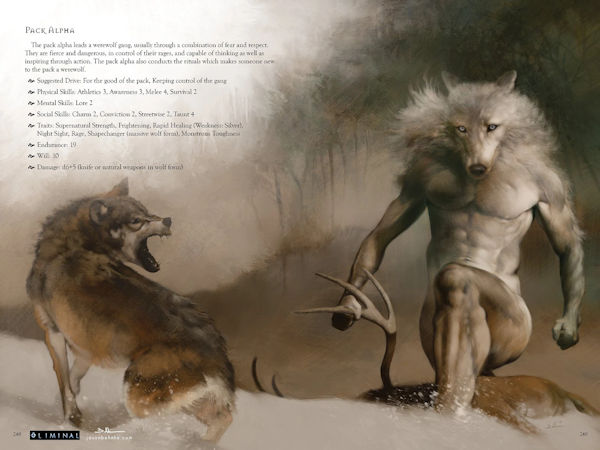
Werewolves in Liminal are not tied to the phases of the Moon, they shift when they want to. They do tend to have problems with rage, however.
Each werewolf gang has its own traditions, initiation ceremonies and supernatural weaknesses, though all of them date back to the magical traditions of the Saxons.
Some werewolves are well meaning, others indulge in their monstrous nature. All must decide whether to resist the ambitious Jaeger family or join the growing ranks of their werewolf faction. The Jaegers are self-styled werewolf nobility, trying to impose their will upon and exact tribute from the other gangs. Sort of a cross between Sons of Anarchy and The Howling.
There is a Jaeger NPC, he hunts humans for sport. Let’s hope this family doesn’t manage to achieve their ambitions!
Smaller Factions
- The Aldermen: This faction has lost most of its influence, but still retains a few tricks. They stand guard over entrances to Fae Domains, Ghost Realms and portals that grant magical passage between mundane locations.
- House Annyn: Descendants of ancient Welsh Druids. They wield old magic and hoard the legendary magical treasures of Britain.
- Flowers of Expression: More of a movement than an organisation, they are a collection of artists, both mortal and Liminal. They don’t usually make moral judgements of their members and may even accept vampires into their ranks.
- Ravenstower: Royalist magicians with strong ties to the Fae dating back to the Norman Conquest. They still hunt for a lost tower of the Tower of London. (Yes, the Tower of London has multiple towers.)
Notably, Liminal does not include demons or angels. The book does not explicitly state beings of Abrahamic mythology don’t exist in its setting, it simply doesn’t discuss them. In fairness, this is a British RPG, and sidestepping any questions that relate to large modern religions is a very British thing to do.
Chapter 7: Liminal Britain and Northern Ireland
The authors make a point of stating this Chapter deliberately only picks out some places in the UK, to give a flavour of the Hidden World. There are some interesting nuggets of information, nonetheless.
- Belfast’s Titanic Museum is a nexus of geomantic power.
- Caernarfon is where the heir to the throne is invested as the Prince of Wales by the Royal Family. Magicians believe this grants the heir incredible magical power over the land of Wales itself.
- I’ll let the authors speak for themselves regarding Liverpool: “The city’s fabled Liver Birds are its supernatural guardians, and a magician who knows the forgotten rituals can call them from the metal sculptures atop the two clock towers of the Royal Liver Building. They will also, according to legend, come to help when the city is under threat, but should they ever leave, the River Mersey will dry up.”
- And Manchester: “Ghostly black dogs, harbingers of death and bringers of bad luck, congregate around the Urbis Centre on most nights.”
- Then there’s Glastonbury—home of haunted ruins and the alleged final resting place of King Arthur. It is the entrance to Gwyn Ap Nudd’s realm of Summer. And invisible Fae and long dead musicians play there in the off season.
- The Time Ceremony, performed at Merton College in Oxford and involving the drinking of port while walking backwards around the Quad, mystically boosts the academic prowess of the students while on campus.
- The Forest of Dean contains the Puzzlewood—a place where no one can inflict harm on another person, and all sorts of chaos can be caused and ultimately resolved. Nearby, is the Fae Inn called, The Lost Angel.
- Winchester is haunted by the ghost of a limping monk, who is always glimpsed near the Cathedral.
I really enjoy the way this book teases out the magic inherent in the British landscape and its folklore. And the way it highlights some truly fascinating locations, such as Portmeirion, the brightly painted artificial village in Wales which, according to this book, has hidden occult significance. (Also, the Scots village of Peebles is a retirement community for legendary and magical beings, including Queen Titania.)
There are some more practical points, such as a note that Glasgow doesn’t deserve its reputation for violence (at least, not anymore), or the incredible ethnic diversity of London’s population. (The Fae beings of London are similarly diverse, including Rakshasas, Loogaroos, Djinn and other creatures from around the world.)
We also get plenty of plot hooks based around all the different factions and types of supernatural being. Vampire nests in abandoned subway systems and rogue wizards in hiding from larger factions. Ghost dragons bound by ancient wards. Witch spirits trapped in church stones.
Chapter 8: Being a Game Master
This Chapter contains a good, practical, process-driven guide to building cases for your players to unravel. It’s excellent for new GMs and probably helpful to the more experienced too. As always, the writing is brief and to the point, making it easily digestible. But the writers fit in some useful tips, such as rotating the game’s focus between different factions and spotlighting different PCs’ Drives to maintain player interest. There is also some solid advice on success and failure and what they should mean. (This can be tricky for new GMs, so is definitely a welcome inclusion.)
 Then there is a section on Otherworldly Places, describing Fae Domains and Ghost Realms in more detail. Fae Domains make use of many urban fantasy tropes. Each Domain has its own weird rules, disobeying them will bring nasty consequences. You’d be well advised to research the Domain beforehand if you can.
Then there is a section on Otherworldly Places, describing Fae Domains and Ghost Realms in more detail. Fae Domains make use of many urban fantasy tropes. Each Domain has its own weird rules, disobeying them will bring nasty consequences. You’d be well advised to research the Domain beforehand if you can.
Ghost Realms only appear, or are only accessible, at certain times. Once inside, you can interact with ghosts as though they were physical. (And they can interact with you, so, be polite!)
Finally, in Liminal Outside the United Kingdom, we get a bit of information about a couple of cities in other parts of the world. I particularly liked Berlin, with its competing factions of outsider scientists, Rosicrucians, vampires and mangy shapeshifters. Also, one of the Berlin factions is called Zerfetzte Schar, which means The Tattered Crowd. And that is just damn cool.
Chapter 9: Many Faces
This chapter helps GMs create NPCs and antagonists to throw at their players.
We start with New Traits, i.e., Traits that would be useless to PCs (or too powerful for them). Again these feed into the tropes of urban fantasy—the power to make supernaturally binding bargains, being unaffected by physical weapons, and being a literal omen of misfortune who inflicts bad luck on the Crew just by meeting them.
There are some sample NPCs and monsters as well—Fae, werewolves, ghosts, vampires, magicians, and mortals. Broad types and power levels of creature are defined and statted out—fae nobles, physical ghosts, werewolf foot-soldiers, vampire lords and so on.
Here, the terse nature of the book becomes less of a strength, in my opinion. The usual way a fantasy RPG antagonists chapter works is ‘look at all these cool monsters you can fight’. This one is more ‘look at all these cool NPCs you can make, here’s a few I made earlier’.
It’s not my preferred approach, but it’s a valid one. Liminal assumes you will build your own unique NPCs using the Traits provided. And it’s very easy to do that with this system, particularly if you use the templates in this chapter as a jumping off point. And even without modifications, this section certainly gives you all you need to tangle with every major faction and supernatural type for at least a couple of cases each.
There are a few interesting points and creatures. I loved the Nikor, which is a sort of incredibly powerful ghost dragon who rules over a Ghost Realm with an iron fist, (claw?). The Duppy, a malevolent spirit from Caribbean folklore, is also a welcome inclusion.
Gremlins get a mention, (and a cool picture). Vampire fledglings, though relatively weak by supernatural standards, are violent and bloodthirsty, with very poor impulse control. Older vampires are more calculating, but ultimately more dangerous to society at large.
I also liked that the weakest type of werewolf is one who has left their gang and is trying to resist their wild nature.
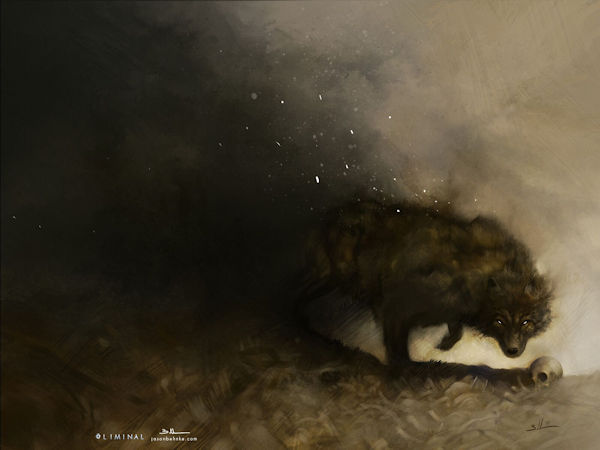
(Check out the Magonomia RPG for some more specific British folkloric creatures, by the way.)
Chapter 10: Sample Cases
The book ends with two sample cases. You won’t be surprised to learn these cases are described in a straightforward but helpful manner. The authors give you enough to get the job done, but don’t get bogged down in detail or lyrical descriptions. This will most likely suit more experienced GMs the best.
Set in York, the “Goblin Market” begins in the eponymous market and features Fae bargains, musical ambitions, and a vampire cell. Be wary of buying things in the Goblin Market, you will be expected to pay in memories, dreams, or other precious possessions. A classic creature from British folklore makes an appearance too. It’s an easy case to follow and run.
The Book of Blood is set in sunny Brighton. (Well, sometimes it’s sunny there.) It involves more vampire shenanigans, dark magic, and lost memories. Presuming the case goes as expected, it will end in a complicated situation that won’t be easily solved by violence.
Conclusion
Liminal’s system alone is worth the price of admission. So clean, so simple, so easy to customise to whatever setting you prefer. It’s more flexible than Powered by the Apocalypse, easier to explain than FATE and far simpler than Storyteller. I am tempted to make it my go-to system for running one-shots in settings that don’t have their own RPGs.
The setting is rooted in British folklore and history, with enough new twists to make it unique. It really made me want to rediscover the magic of my home country. If you’re a Brit, you’ll likely get a kick out of seeing familiar places get a new coat of mythical paint. If you’re not a UK resident, this is a great introduction to playing in a modern British setting.
Liminal feels gritty and grounded in a way that will appeal to readers of Rivers of London, or those who are put off by more epic fantasy or pulpy action settings. It’s a great fit for fans of Call of Cthulhu, Night’s Black Agents, or World of Darkness: Mortal.
As I mentioned earlier, this is a brilliant game for capturing the spirit of urban fantasy. Not just vampires with sunglasses and hunky werewolves in search of a mate, but gods who are down on their luck, fey creatures who will burn you alive for failing to say please, and shadowy beings who can vanish from your memory as soon as they’re out of your sight. Not to mention impossible pocket dimensions, warring secret societies and mystical bargains.
I love the way that Liminal leaves the door open for any sort of magic or mythical being you like.
- Want a tradition of weather-controlling Brazilian were-dolphins? Go for it.
- Want your vampire to be allergic to salt but capable of detaching their own head and sending it flying off to attack their enemies? Sure.
- Want to bring in Felix Castor or Alex Verus? No problem, even if you can’t build them with the existing Traits and magical styles, you can throw your own together very easily.
Fantasy lovers will enjoy the mythological aspects. New and story-focused gamers will love the simple mechanics. Horror gamers will appreciate the nasty creatures and investigative focus. The beautiful artwork is just the icing on the cake.
Definitely recommended, go check it out!

Disclaimer: I received a free digital copy of this RPG in return for an honest review.

